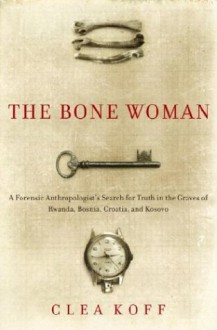
The Bone Woman
by Clea Koff
In order to prosecute war crimes and crimes against humanity, the UN needs to know the answer to one question: Are the bodies those of noncombatants? To answer this, one must learn who the victims were, and how they were killed. Only one group of specialists in the world can make both those determinations: forensic anthropologists, trained to identify otherwise unidentifiable human remains by analyzing their skeletons. Forensic anthropologists unlock the stories of people’s lives, as well as of their last moments.
Koff’s unflinching account of her years with the UN—what she saw, how it affected her, who was prosecuted based on evidence she found, what she learned about the world—is alternately gripping, frightening, and miraculously hopeful. Readers join Koff as she comes face-to-face with the realities of genocide: nearly five hundred bodies exhumed from a single grave in Kibuye, Rwanda; the wire-bound wrists of Srebrenica massacre victims uncovered in Bosnia; the disinterment of the body of a young man in southwestern Kosovo as his grandfather looks on in silence.
Yet even as she recounts the hellish working conditions, the tangled bureaucracy of the UN, and the heartbreak of survivors, Koff imbues her story with purpose, humanity, and an unfailing sense of justice. This is a book only Clea Koff could have written, charting her journey from wide-eyed innocent to soul-weary veteran across geography synonymous with some of the worst crimes of the twentieth century. A tale of science in the service of human rights, The Bone Woman is, even more profoundly, a story of hope and enduring moral principles.
I ended up skipping the rest of the status updates I'd initially planned, if only because I ended up just reading the book and enjoying myself leisurely. Aside from that, I found I couldn't really find anything thoughtful to add to discussion anyway, outside of highlighting three or four passages in each of the books's parts that stood out to me. If I were going to do that, then I might as well just tell everyone to just read the book. After all, despite a few moments where I felt the book dragged a little, I feel like The Bone Woman is a very worthwhile read.
There is a lot more detail in the first parts devoted to the Rwandan genocide, and the latter parts of Bosnia, Croatia, and Kosovo were more heavy in detailing site management, with more anthropological findings (which I DID actually enjoy reading about). There were moments where I thought that the author maybe should have chosen not to harp on mean teammates and team disharmony, too much. Mentioning it once or twice was fine, and I can only imagine just how stressed and emotionally taxed everyone on these missions were becoming. But after a while, it just started sounding like complaining, and kind of distracted from the bigger picture of the book.
As I've already mentioned, I don't have a lot to say about this book, and will gladly direct anyone to Themis-Athena's book updates, that give a lot of extra information, as complementary reading to this book, on each of the mentioned missions that Koff was involved in. In truth, this is probably one of those books that I would have read and simply stated that it was compelling and thought-provoking, and left it at that. I'm no good at reviewing these kinds of books anyway, the kind where you liked it, but didn't really love it, but still feel like it's a book you'd highly recommend to others.
So that's what I will do. I've always found nonfictional works a bit more difficult to read, but The Bone Woman never felt like a chore to me. So overall, I found that I quite enjoyed the book and found it quite inspiring.
Meanwhile, with her permission, I've included the links to Themis-Athena's reading updates, and her review below. I highly recommend reading these, as they really add to the reading experience of The Bone Woman.
79 of 277 | 112 of 277 | 157 of 277 | 194 of 277 | 256 of 277 | Review

 Log in with Facebook
Log in with Facebook 






